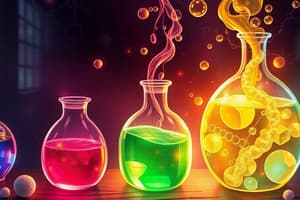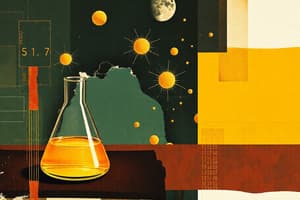Podcast
Questions and Answers
What happens during a combustion reaction?
What happens during a combustion reaction?
- Two molecules interact to form a single molecule.
- A single reactant breaks down into multiple products.
- Oxygen combines with a compound to form carbon dioxide and water. (correct)
- Water and salt are produced.
How is a synthesis reaction defined?
How is a synthesis reaction defined?
- It is a reaction where a reactant produces heat.
- Two or more substances combine to form a new compound. (correct)
- It involves the breakdown of a compound into simpler substances.
- It occurs between an acid and a base to form water and salt.
Which of the following statements regarding balancing chemical equations is true?
Which of the following statements regarding balancing chemical equations is true?
- Reactants can have different types of atoms than products.
- Balancing is only needed for combustion reactions.
- You can change the subscripts to balance a chemical equation.
- The number of atoms of each element must be equal on both sides. (correct)
What type of reaction occurs during the burning of a candle?
What type of reaction occurs during the burning of a candle?
What does an acid-base reaction typically produce?
What does an acid-base reaction typically produce?
What are substances that react with one another called?
What are substances that react with one another called?
Which of the following is NOT a sign of a chemical change?
Which of the following is NOT a sign of a chemical change?
What is the term for the substances produced by a chemical reaction?
What is the term for the substances produced by a chemical reaction?
How is an exothermic reaction characterized?
How is an exothermic reaction characterized?
Which of the following processes is an example of a chemical change?
Which of the following processes is an example of a chemical change?
Which of the following statements best describes a physical change?
Which of the following statements best describes a physical change?
What happens to old bonds in reactants during a chemical reaction?
What happens to old bonds in reactants during a chemical reaction?
Which of the following reactions requires energy input to proceed?
Which of the following reactions requires energy input to proceed?
Flashcards
Exothermic Reaction
Exothermic Reaction
A chemical reaction that releases energy to the surroundings, often as heat.
Endothermic Reaction
Endothermic Reaction
A chemical reaction that absorbs energy from the surroundings, often as heat.
Combustion
Combustion
A chemical reaction where oxygen combines with a compound to form carbon dioxide and water.
Balancing Chemical Equations
Balancing Chemical Equations
Signup and view all the flashcards
Chemical Equation
Chemical Equation
Signup and view all the flashcards
Chemical Reaction
Chemical Reaction
Signup and view all the flashcards
Reactants
Reactants
Signup and view all the flashcards
Products
Products
Signup and view all the flashcards
Chemical Change
Chemical Change
Signup and view all the flashcards
Physical Change
Physical Change
Signup and view all the flashcards
Exothermic Reaction
Exothermic Reaction
Signup and view all the flashcards
Endothermic Reaction
Endothermic Reaction
Signup and view all the flashcards
Sign of Chemical Change
Sign of Chemical Change
Signup and view all the flashcards
Study Notes
Chemical Reactions
- Chemical reaction: Substances react to form new substances with different chemical properties.
Definitions
- Reactants: Substances that react with each other.
- Products: Substances formed from the reaction.
- Chemical change: A reaction that forms new products.
- Physical change: A change in state (phase) without changing the chemical form.
Parts of a Chemical Reaction
- Reactants are the starting substances.
- Products are the substances formed in the reaction.
- Example: 2H₂(g) + O₂(g) → 2H₂O(l)
- Reactants: 2H₂ (g) , O₂(g)
- Product: 2H₂O(l)
How to Tell if a Chemical Reaction is Taking Place
- Color change
- Gas production (bubbles, fizzing)
- Temperature change (heat or cold)
- Formation of a precipitate (solid forming from a liquid)
- Smell
Examples of Chemical Changes
- Burning wood
- Rotting fruit
- Baking a cake
- Rusting metal
- Using a battery
- Digestion
- Souring milk
- Exploding fireworks
- Cooking an egg
- Photosynthesis
Class Activity
- Examples of chemical changes.
- Signs of chemical change for each example.
Homework
- Page 48 classify substances.
- Revision exercise question 1-4.
- Complete balancing equations worksheet.
- Research examples of exothermic and endothermic reactions on page 55
Chemical Change
- Chemical change: New products are formed when old bonds break and new bonds form between products, resulting in a new product/molecule.
- Example: Rust
Phase Change
- Physical change: When a substance changes phases (solid, liquid, gas) the molecule remains the same, and it can return to its original form.
- Example: Water changing to steam
Energy Changes
- Exothermic reactions: More energy is given out than is required. Energy is lost to the surroundings, and the product is colder than the reactants.
- Example: Burning a candle
- Endothermic reactions: More energy has to be put in than is given out. Energy is taken from the surroundings, and the product is warmer than the reactants.
- Example: Baking bread
Types of Chemical Reactions
- Combustion
- Synthesis
- Acid-base reactions
- Decomposition
Combustion
- Oxygen combines with a compound to form carbon dioxide and water.
- Example: Fuel + O₂ → CO₂ + H₂O
Synthesis
- Two molecules interact to form a different molecule.
- Example: A + B → AB
Acid-Base Reactions
- A chemical reaction between an acid and a base forms water and a salt.
- Example: Acid + Base → H₂O + Salt
Decomposition
- A reactant breaks down into two or more products.
- Example: AB → A + B
Balancing Chemical Equations
- The number of atoms of each element must be the same on both sides of the equation.
Studying That Suits You
Use AI to generate personalized quizzes and flashcards to suit your learning preferences.





